Strategic Ambidexterity: Challenges and Recommendations Report
VerifiedAdded on 2023/02/03
|12
|3518
|21
Report
AI Summary
This report examines the concept of ambidexterity within a business context, specifically focusing on a Matchbox Architect (MBA). It explores how organizations can balance exploring new opportunities and exploiting existing resources to increase profits and productivity. The report analyzes the application of ambidexterity in leadership, operational management, and accounting management. It discusses the strategies for exploring new markets, designing innovative products, and managing financial aspects. Furthermore, it identifies the challenges faced during the exploration and exploitation processes, such as lack of managerial skills, uncertainties, and insufficient energy for exploitation. The report provides recommendations for overcoming these challenges and successfully implementing ambidexterity to achieve business goals. The report emphasizes the importance of structural and contextual ambidexterity, and the need for leaders to adapt to changing environments. Ultimately, the report concludes that ambidexterity is crucial for organizations to remain competitive and adapt to future demands. This report has been contributed by a student and is available on Desklib, a platform providing AI-based study tools for students.
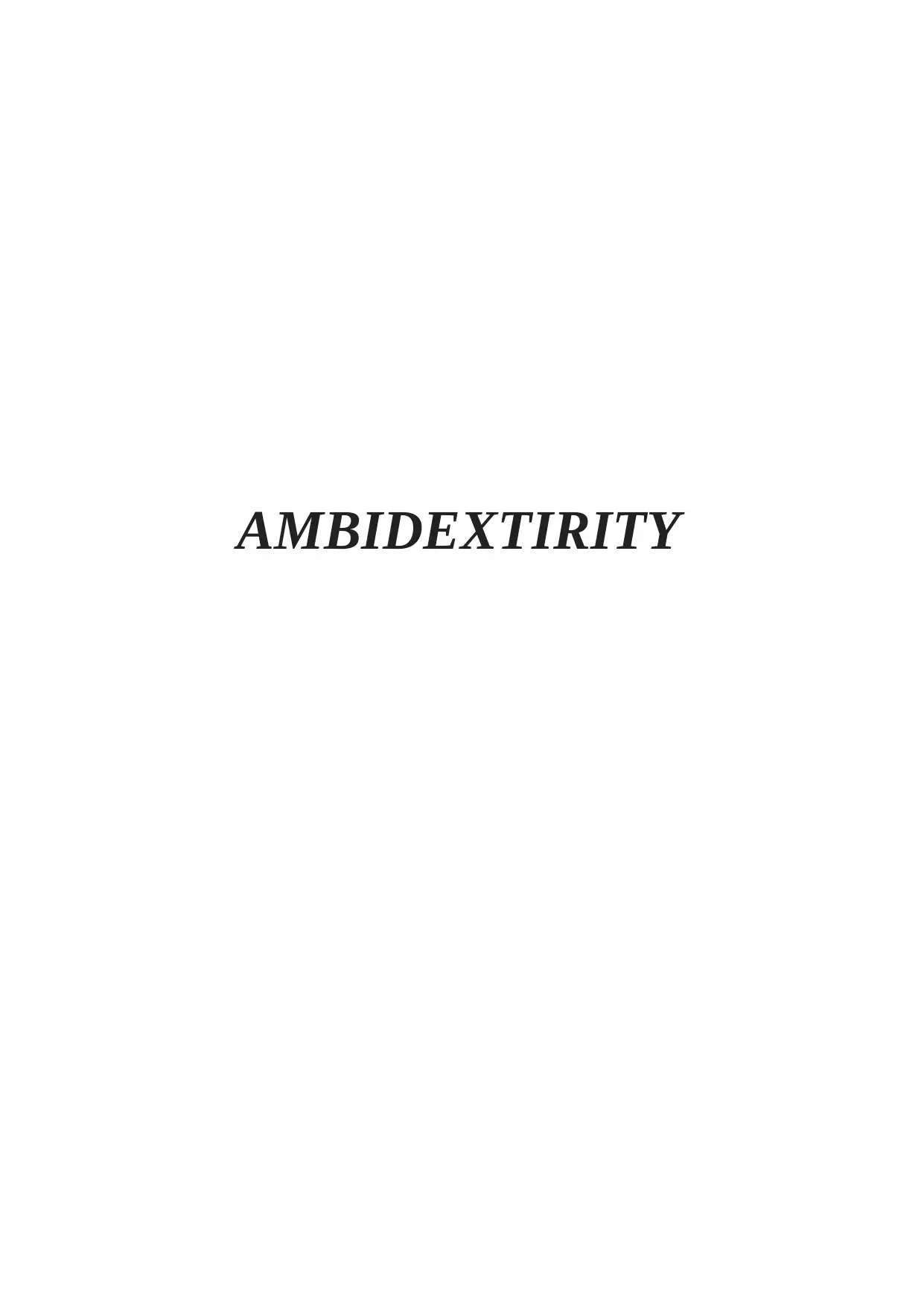
AMBIDEXTIRITY
Paraphrase This Document
Need a fresh take? Get an instant paraphrase of this document with our AI Paraphraser
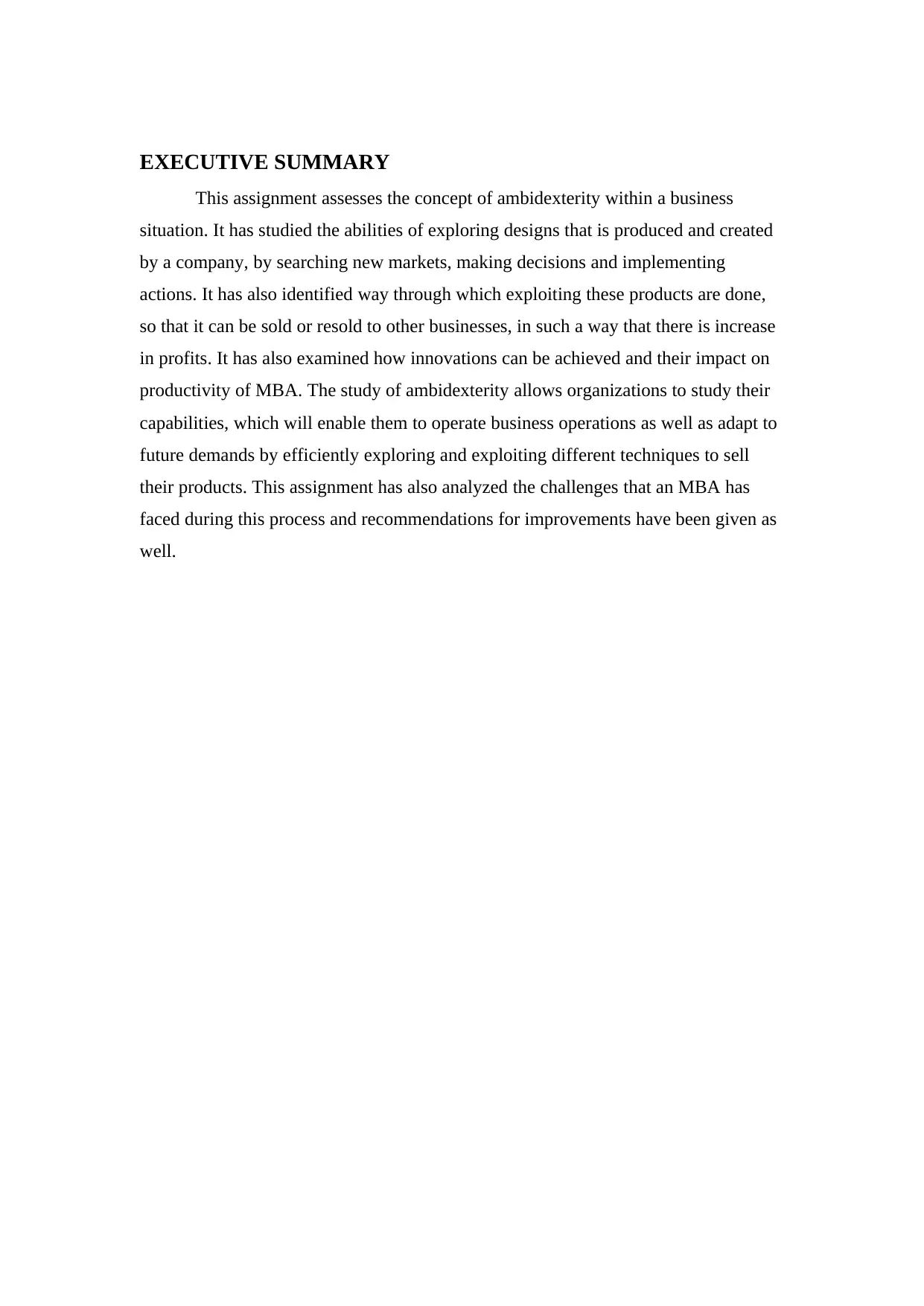
EXECUTIVE SUMMARY
This assignment assesses the concept of ambidexterity within a business
situation. It has studied the abilities of exploring designs that is produced and created
by a company, by searching new markets, making decisions and implementing
actions. It has also identified way through which exploiting these products are done,
so that it can be sold or resold to other businesses, in such a way that there is increase
in profits. It has also examined how innovations can be achieved and their impact on
productivity of MBA. The study of ambidexterity allows organizations to study their
capabilities, which will enable them to operate business operations as well as adapt to
future demands by efficiently exploring and exploiting different techniques to sell
their products. This assignment has also analyzed the challenges that an MBA has
faced during this process and recommendations for improvements have been given as
well.
This assignment assesses the concept of ambidexterity within a business
situation. It has studied the abilities of exploring designs that is produced and created
by a company, by searching new markets, making decisions and implementing
actions. It has also identified way through which exploiting these products are done,
so that it can be sold or resold to other businesses, in such a way that there is increase
in profits. It has also examined how innovations can be achieved and their impact on
productivity of MBA. The study of ambidexterity allows organizations to study their
capabilities, which will enable them to operate business operations as well as adapt to
future demands by efficiently exploring and exploiting different techniques to sell
their products. This assignment has also analyzed the challenges that an MBA has
faced during this process and recommendations for improvements have been given as
well.
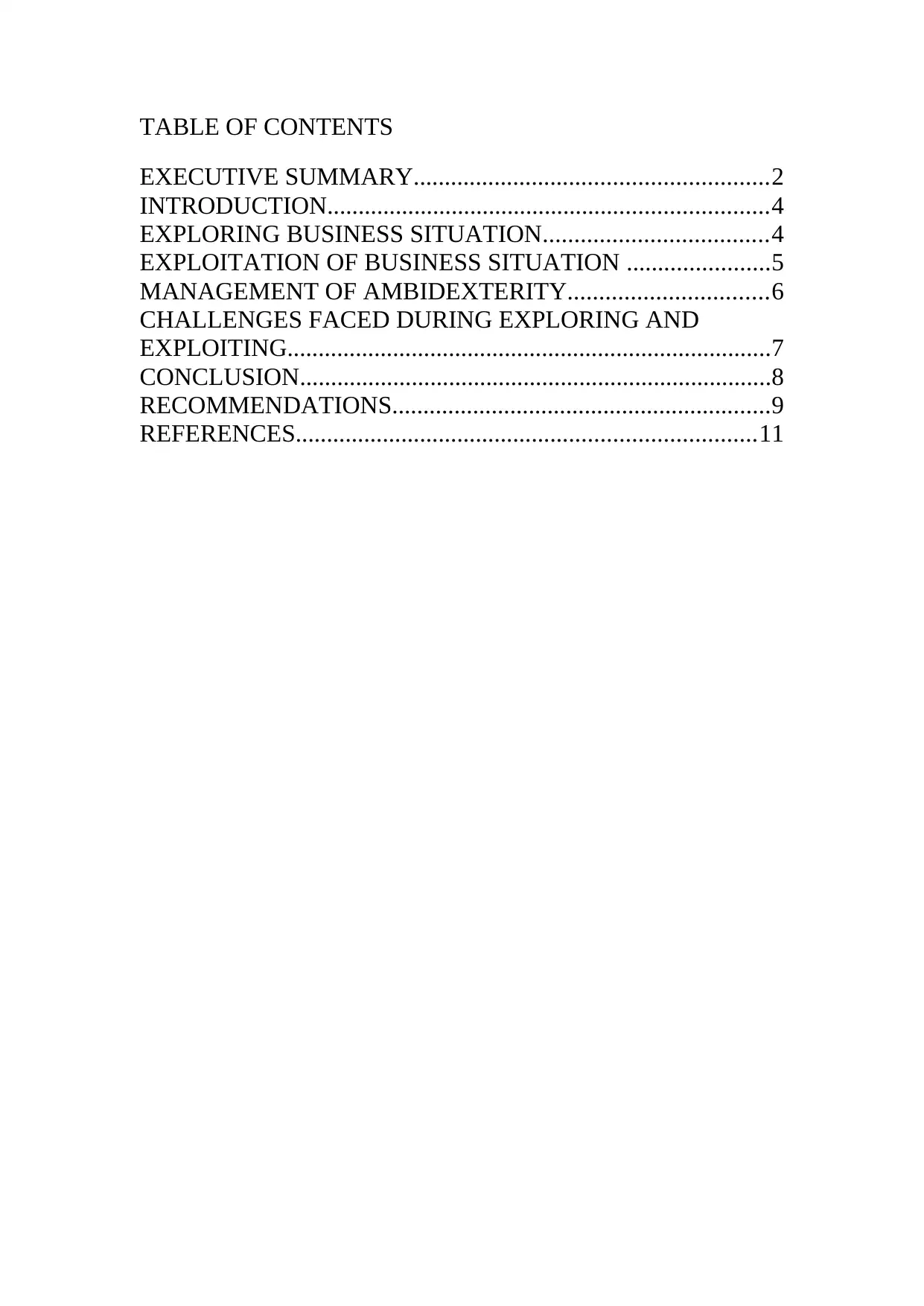
TABLE OF CONTENTS
EXECUTIVE SUMMARY.........................................................2
INTRODUCTION.......................................................................4
EXPLORING BUSINESS SITUATION....................................4
EXPLOITATION OF BUSINESS SITUATION .......................5
MANAGEMENT OF AMBIDEXTERITY................................6
CHALLENGES FACED DURING EXPLORING AND
EXPLOITING..............................................................................7
CONCLUSION............................................................................8
RECOMMENDATIONS.............................................................9
REFERENCES..........................................................................11
EXECUTIVE SUMMARY.........................................................2
INTRODUCTION.......................................................................4
EXPLORING BUSINESS SITUATION....................................4
EXPLOITATION OF BUSINESS SITUATION .......................5
MANAGEMENT OF AMBIDEXTERITY................................6
CHALLENGES FACED DURING EXPLORING AND
EXPLOITING..............................................................................7
CONCLUSION............................................................................8
RECOMMENDATIONS.............................................................9
REFERENCES..........................................................................11
⊘ This is a preview!⊘
Do you want full access?
Subscribe today to unlock all pages.

Trusted by 1+ million students worldwide
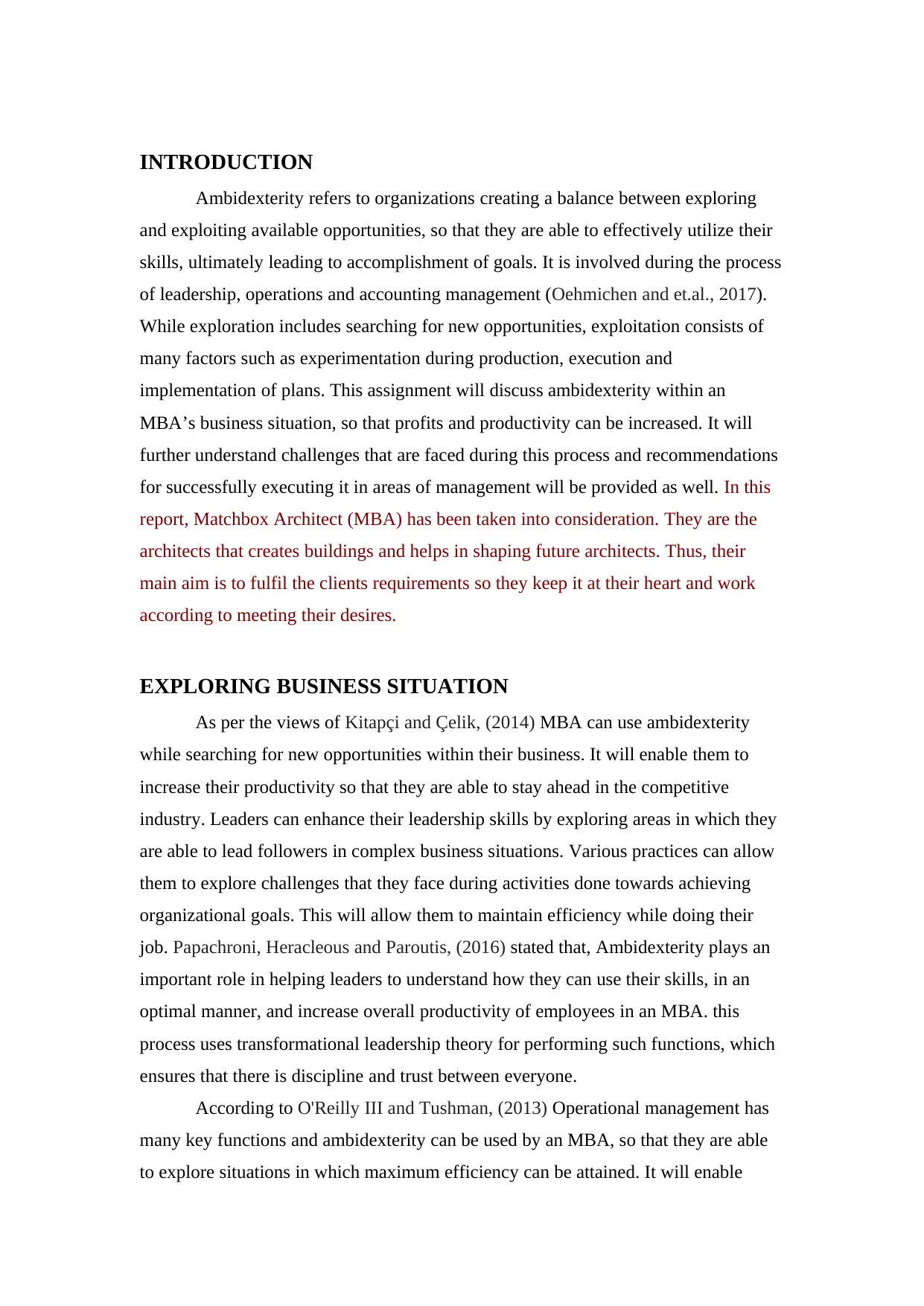
INTRODUCTION
Ambidexterity refers to organizations creating a balance between exploring
and exploiting available opportunities, so that they are able to effectively utilize their
skills, ultimately leading to accomplishment of goals. It is involved during the process
of leadership, operations and accounting management (Oehmichen and et.al., 2017).
While exploration includes searching for new opportunities, exploitation consists of
many factors such as experimentation during production, execution and
implementation of plans. This assignment will discuss ambidexterity within an
MBA’s business situation, so that profits and productivity can be increased. It will
further understand challenges that are faced during this process and recommendations
for successfully executing it in areas of management will be provided as well. In this
report, Matchbox Architect (MBA) has been taken into consideration. They are the
architects that creates buildings and helps in shaping future architects. Thus, their
main aim is to fulfil the clients requirements so they keep it at their heart and work
according to meeting their desires.
EXPLORING BUSINESS SITUATION
As per the views of Kitapçi and Çelik, (2014) MBA can use ambidexterity
while searching for new opportunities within their business. It will enable them to
increase their productivity so that they are able to stay ahead in the competitive
industry. Leaders can enhance their leadership skills by exploring areas in which they
are able to lead followers in complex business situations. Various practices can allow
them to explore challenges that they face during activities done towards achieving
organizational goals. This will allow them to maintain efficiency while doing their
job. Papachroni, Heracleous and Paroutis, (2016) stated that, Ambidexterity plays an
important role in helping leaders to understand how they can use their skills, in an
optimal manner, and increase overall productivity of employees in an MBA. this
process uses transformational leadership theory for performing such functions, which
ensures that there is discipline and trust between everyone.
According to O'Reilly III and Tushman, (2013) Operational management has
many key functions and ambidexterity can be used by an MBA, so that they are able
to explore situations in which maximum efficiency can be attained. It will enable
Ambidexterity refers to organizations creating a balance between exploring
and exploiting available opportunities, so that they are able to effectively utilize their
skills, ultimately leading to accomplishment of goals. It is involved during the process
of leadership, operations and accounting management (Oehmichen and et.al., 2017).
While exploration includes searching for new opportunities, exploitation consists of
many factors such as experimentation during production, execution and
implementation of plans. This assignment will discuss ambidexterity within an
MBA’s business situation, so that profits and productivity can be increased. It will
further understand challenges that are faced during this process and recommendations
for successfully executing it in areas of management will be provided as well. In this
report, Matchbox Architect (MBA) has been taken into consideration. They are the
architects that creates buildings and helps in shaping future architects. Thus, their
main aim is to fulfil the clients requirements so they keep it at their heart and work
according to meeting their desires.
EXPLORING BUSINESS SITUATION
As per the views of Kitapçi and Çelik, (2014) MBA can use ambidexterity
while searching for new opportunities within their business. It will enable them to
increase their productivity so that they are able to stay ahead in the competitive
industry. Leaders can enhance their leadership skills by exploring areas in which they
are able to lead followers in complex business situations. Various practices can allow
them to explore challenges that they face during activities done towards achieving
organizational goals. This will allow them to maintain efficiency while doing their
job. Papachroni, Heracleous and Paroutis, (2016) stated that, Ambidexterity plays an
important role in helping leaders to understand how they can use their skills, in an
optimal manner, and increase overall productivity of employees in an MBA. this
process uses transformational leadership theory for performing such functions, which
ensures that there is discipline and trust between everyone.
According to O'Reilly III and Tushman, (2013) Operational management has
many key functions and ambidexterity can be used by an MBA, so that they are able
to explore situations in which maximum efficiency can be attained. It will enable
Paraphrase This Document
Need a fresh take? Get an instant paraphrase of this document with our AI Paraphraser
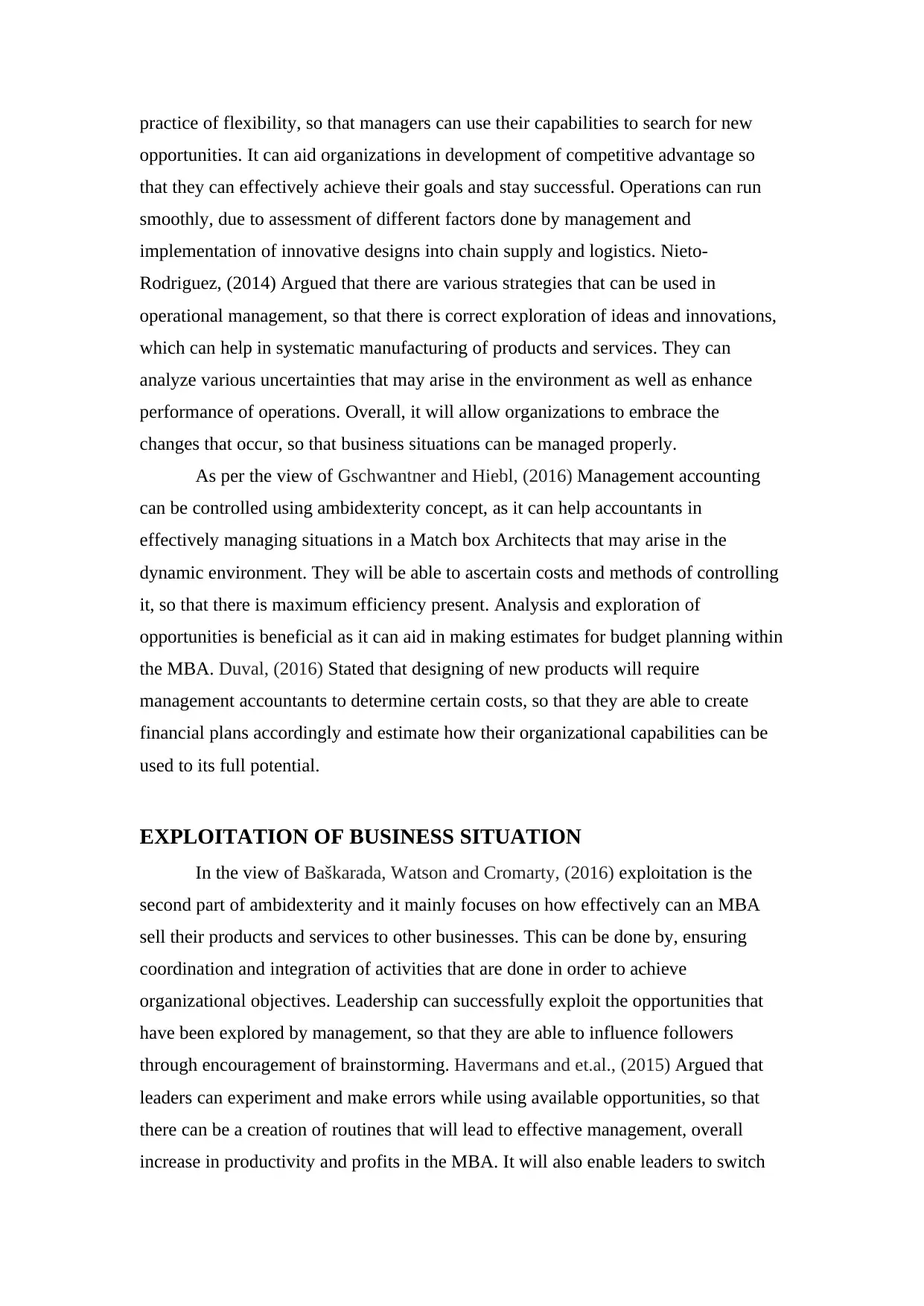
practice of flexibility, so that managers can use their capabilities to search for new
opportunities. It can aid organizations in development of competitive advantage so
that they can effectively achieve their goals and stay successful. Operations can run
smoothly, due to assessment of different factors done by management and
implementation of innovative designs into chain supply and logistics. Nieto-
Rodriguez, (2014) Argued that there are various strategies that can be used in
operational management, so that there is correct exploration of ideas and innovations,
which can help in systematic manufacturing of products and services. They can
analyze various uncertainties that may arise in the environment as well as enhance
performance of operations. Overall, it will allow organizations to embrace the
changes that occur, so that business situations can be managed properly.
As per the view of Gschwantner and Hiebl, (2016) Management accounting
can be controlled using ambidexterity concept, as it can help accountants in
effectively managing situations in a Match box Architects that may arise in the
dynamic environment. They will be able to ascertain costs and methods of controlling
it, so that there is maximum efficiency present. Analysis and exploration of
opportunities is beneficial as it can aid in making estimates for budget planning within
the MBA. Duval, (2016) Stated that designing of new products will require
management accountants to determine certain costs, so that they are able to create
financial plans accordingly and estimate how their organizational capabilities can be
used to its full potential.
EXPLOITATION OF BUSINESS SITUATION
In the view of Baškarada, Watson and Cromarty, (2016) exploitation is the
second part of ambidexterity and it mainly focuses on how effectively can an MBA
sell their products and services to other businesses. This can be done by, ensuring
coordination and integration of activities that are done in order to achieve
organizational objectives. Leadership can successfully exploit the opportunities that
have been explored by management, so that they are able to influence followers
through encouragement of brainstorming. Havermans and et.al., (2015) Argued that
leaders can experiment and make errors while using available opportunities, so that
there can be a creation of routines that will lead to effective management, overall
increase in productivity and profits in the MBA. It will also enable leaders to switch
opportunities. It can aid organizations in development of competitive advantage so
that they can effectively achieve their goals and stay successful. Operations can run
smoothly, due to assessment of different factors done by management and
implementation of innovative designs into chain supply and logistics. Nieto-
Rodriguez, (2014) Argued that there are various strategies that can be used in
operational management, so that there is correct exploration of ideas and innovations,
which can help in systematic manufacturing of products and services. They can
analyze various uncertainties that may arise in the environment as well as enhance
performance of operations. Overall, it will allow organizations to embrace the
changes that occur, so that business situations can be managed properly.
As per the view of Gschwantner and Hiebl, (2016) Management accounting
can be controlled using ambidexterity concept, as it can help accountants in
effectively managing situations in a Match box Architects that may arise in the
dynamic environment. They will be able to ascertain costs and methods of controlling
it, so that there is maximum efficiency present. Analysis and exploration of
opportunities is beneficial as it can aid in making estimates for budget planning within
the MBA. Duval, (2016) Stated that designing of new products will require
management accountants to determine certain costs, so that they are able to create
financial plans accordingly and estimate how their organizational capabilities can be
used to its full potential.
EXPLOITATION OF BUSINESS SITUATION
In the view of Baškarada, Watson and Cromarty, (2016) exploitation is the
second part of ambidexterity and it mainly focuses on how effectively can an MBA
sell their products and services to other businesses. This can be done by, ensuring
coordination and integration of activities that are done in order to achieve
organizational objectives. Leadership can successfully exploit the opportunities that
have been explored by management, so that they are able to influence followers
through encouragement of brainstorming. Havermans and et.al., (2015) Argued that
leaders can experiment and make errors while using available opportunities, so that
there can be a creation of routines that will lead to effective management, overall
increase in productivity and profits in the MBA. It will also enable leaders to switch

leadership styles, so that they can change they way they lead, when the environment
changes.
Kortmann and et.al., (2014) stated that operational management is key when it
comes to achievement of objectives in an MBA. There has to be full exploitation of
resources that have been identified, as it allows managers to make proper decisions
regarding production and sales of products that is begin manufactured and sold. In
order to do so, there has to be exploration done beforehand. It can give an idea to
management on how supply chain and other factors of operations can be created so
that there is increase in productivity and profits. According to Nieto-Rodriguez,
(2014) Operational management needs to establish a balance between exploring and
exploiting, as it will enable them to make strategic plans that have values and visions
of the MBA, which can be communicated with every manager. This can help in
significantly achieving efficiency in operations, as analysis of opportunities in this
field can be beneficial in creating smooth logistics of products and services that have
to be delivered.
Manneri, (2016) argued that exploitation in the area of management
accounting can help managers to exercise control by utilizing existing resources as
well as the new ones that have been explored. Ambidexterity in organizations allows
action-orientated approaches that can be used by accountants, as they will be able to
ascertain the plans of financials that have to be made. While Walrave, B. and et.al.,
(2017) stated that exploitation can help management in effectively creating budgets
through utilization of new and old resources at the same time. It will ensure that there
is long-term survival of MBA. However, there is not much clarity present and this can
cause confusion in managers or accountants when they prepare or analyze financial
records.
MANAGEMENT OF AMBIDEXTERITY
Organizations that use ambidexterity while performing functions such as
leadership, operations and management accounting can have an advantage in
competition. According to Oehmichen and et.al., (2017) the balance that is created
between exploring and exploiting can help management when dealing with complex
situations that arise in a business. This systematic process utilizes organizational,
social and human resources in such a way that there is optimum usage of new
changes.
Kortmann and et.al., (2014) stated that operational management is key when it
comes to achievement of objectives in an MBA. There has to be full exploitation of
resources that have been identified, as it allows managers to make proper decisions
regarding production and sales of products that is begin manufactured and sold. In
order to do so, there has to be exploration done beforehand. It can give an idea to
management on how supply chain and other factors of operations can be created so
that there is increase in productivity and profits. According to Nieto-Rodriguez,
(2014) Operational management needs to establish a balance between exploring and
exploiting, as it will enable them to make strategic plans that have values and visions
of the MBA, which can be communicated with every manager. This can help in
significantly achieving efficiency in operations, as analysis of opportunities in this
field can be beneficial in creating smooth logistics of products and services that have
to be delivered.
Manneri, (2016) argued that exploitation in the area of management
accounting can help managers to exercise control by utilizing existing resources as
well as the new ones that have been explored. Ambidexterity in organizations allows
action-orientated approaches that can be used by accountants, as they will be able to
ascertain the plans of financials that have to be made. While Walrave, B. and et.al.,
(2017) stated that exploitation can help management in effectively creating budgets
through utilization of new and old resources at the same time. It will ensure that there
is long-term survival of MBA. However, there is not much clarity present and this can
cause confusion in managers or accountants when they prepare or analyze financial
records.
MANAGEMENT OF AMBIDEXTERITY
Organizations that use ambidexterity while performing functions such as
leadership, operations and management accounting can have an advantage in
competition. According to Oehmichen and et.al., (2017) the balance that is created
between exploring and exploiting can help management when dealing with complex
situations that arise in a business. This systematic process utilizes organizational,
social and human resources in such a way that there is optimum usage of new
⊘ This is a preview!⊘
Do you want full access?
Subscribe today to unlock all pages.

Trusted by 1+ million students worldwide
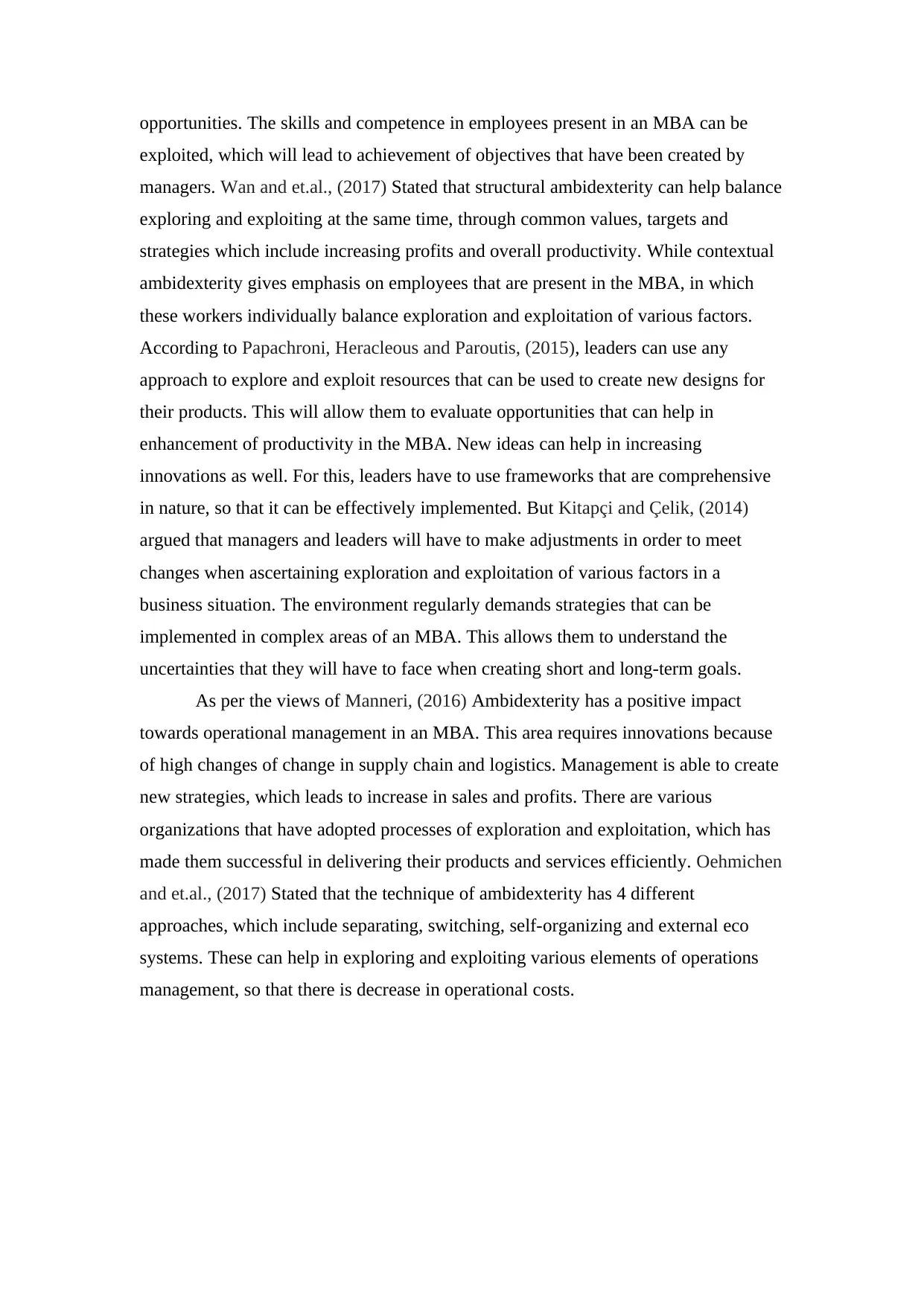
opportunities. The skills and competence in employees present in an MBA can be
exploited, which will lead to achievement of objectives that have been created by
managers. Wan and et.al., (2017) Stated that structural ambidexterity can help balance
exploring and exploiting at the same time, through common values, targets and
strategies which include increasing profits and overall productivity. While contextual
ambidexterity gives emphasis on employees that are present in the MBA, in which
these workers individually balance exploration and exploitation of various factors.
According to Papachroni, Heracleous and Paroutis, (2015), leaders can use any
approach to explore and exploit resources that can be used to create new designs for
their products. This will allow them to evaluate opportunities that can help in
enhancement of productivity in the MBA. New ideas can help in increasing
innovations as well. For this, leaders have to use frameworks that are comprehensive
in nature, so that it can be effectively implemented. But Kitapçi and Çelik, (2014)
argued that managers and leaders will have to make adjustments in order to meet
changes when ascertaining exploration and exploitation of various factors in a
business situation. The environment regularly demands strategies that can be
implemented in complex areas of an MBA. This allows them to understand the
uncertainties that they will have to face when creating short and long-term goals.
As per the views of Manneri, (2016) Ambidexterity has a positive impact
towards operational management in an MBA. This area requires innovations because
of high changes of change in supply chain and logistics. Management is able to create
new strategies, which leads to increase in sales and profits. There are various
organizations that have adopted processes of exploration and exploitation, which has
made them successful in delivering their products and services efficiently. Oehmichen
and et.al., (2017) Stated that the technique of ambidexterity has 4 different
approaches, which include separating, switching, self-organizing and external eco
systems. These can help in exploring and exploiting various elements of operations
management, so that there is decrease in operational costs.
exploited, which will lead to achievement of objectives that have been created by
managers. Wan and et.al., (2017) Stated that structural ambidexterity can help balance
exploring and exploiting at the same time, through common values, targets and
strategies which include increasing profits and overall productivity. While contextual
ambidexterity gives emphasis on employees that are present in the MBA, in which
these workers individually balance exploration and exploitation of various factors.
According to Papachroni, Heracleous and Paroutis, (2015), leaders can use any
approach to explore and exploit resources that can be used to create new designs for
their products. This will allow them to evaluate opportunities that can help in
enhancement of productivity in the MBA. New ideas can help in increasing
innovations as well. For this, leaders have to use frameworks that are comprehensive
in nature, so that it can be effectively implemented. But Kitapçi and Çelik, (2014)
argued that managers and leaders will have to make adjustments in order to meet
changes when ascertaining exploration and exploitation of various factors in a
business situation. The environment regularly demands strategies that can be
implemented in complex areas of an MBA. This allows them to understand the
uncertainties that they will have to face when creating short and long-term goals.
As per the views of Manneri, (2016) Ambidexterity has a positive impact
towards operational management in an MBA. This area requires innovations because
of high changes of change in supply chain and logistics. Management is able to create
new strategies, which leads to increase in sales and profits. There are various
organizations that have adopted processes of exploration and exploitation, which has
made them successful in delivering their products and services efficiently. Oehmichen
and et.al., (2017) Stated that the technique of ambidexterity has 4 different
approaches, which include separating, switching, self-organizing and external eco
systems. These can help in exploring and exploiting various elements of operations
management, so that there is decrease in operational costs.
Paraphrase This Document
Need a fresh take? Get an instant paraphrase of this document with our AI Paraphraser
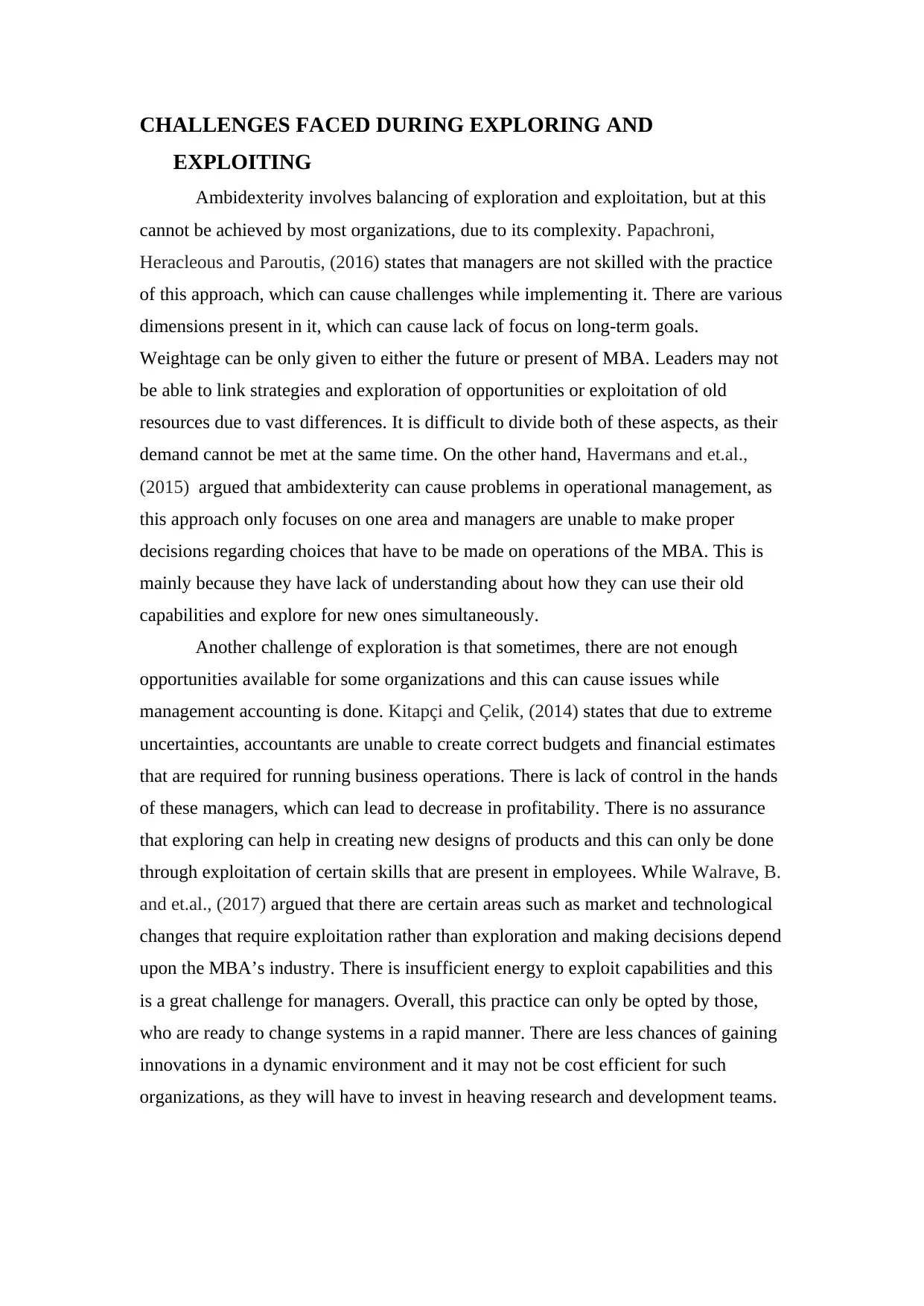
CHALLENGES FACED DURING EXPLORING AND
EXPLOITING
Ambidexterity involves balancing of exploration and exploitation, but at this
cannot be achieved by most organizations, due to its complexity. Papachroni,
Heracleous and Paroutis, (2016) states that managers are not skilled with the practice
of this approach, which can cause challenges while implementing it. There are various
dimensions present in it, which can cause lack of focus on long-term goals.
Weightage can be only given to either the future or present of MBA. Leaders may not
be able to link strategies and exploration of opportunities or exploitation of old
resources due to vast differences. It is difficult to divide both of these aspects, as their
demand cannot be met at the same time. On the other hand, Havermans and et.al.,
(2015) argued that ambidexterity can cause problems in operational management, as
this approach only focuses on one area and managers are unable to make proper
decisions regarding choices that have to be made on operations of the MBA. This is
mainly because they have lack of understanding about how they can use their old
capabilities and explore for new ones simultaneously.
Another challenge of exploration is that sometimes, there are not enough
opportunities available for some organizations and this can cause issues while
management accounting is done. Kitapçi and Çelik, (2014) states that due to extreme
uncertainties, accountants are unable to create correct budgets and financial estimates
that are required for running business operations. There is lack of control in the hands
of these managers, which can lead to decrease in profitability. There is no assurance
that exploring can help in creating new designs of products and this can only be done
through exploitation of certain skills that are present in employees. While Walrave, B.
and et.al., (2017) argued that there are certain areas such as market and technological
changes that require exploitation rather than exploration and making decisions depend
upon the MBA’s industry. There is insufficient energy to exploit capabilities and this
is a great challenge for managers. Overall, this practice can only be opted by those,
who are ready to change systems in a rapid manner. There are less chances of gaining
innovations in a dynamic environment and it may not be cost efficient for such
organizations, as they will have to invest in heaving research and development teams.
EXPLOITING
Ambidexterity involves balancing of exploration and exploitation, but at this
cannot be achieved by most organizations, due to its complexity. Papachroni,
Heracleous and Paroutis, (2016) states that managers are not skilled with the practice
of this approach, which can cause challenges while implementing it. There are various
dimensions present in it, which can cause lack of focus on long-term goals.
Weightage can be only given to either the future or present of MBA. Leaders may not
be able to link strategies and exploration of opportunities or exploitation of old
resources due to vast differences. It is difficult to divide both of these aspects, as their
demand cannot be met at the same time. On the other hand, Havermans and et.al.,
(2015) argued that ambidexterity can cause problems in operational management, as
this approach only focuses on one area and managers are unable to make proper
decisions regarding choices that have to be made on operations of the MBA. This is
mainly because they have lack of understanding about how they can use their old
capabilities and explore for new ones simultaneously.
Another challenge of exploration is that sometimes, there are not enough
opportunities available for some organizations and this can cause issues while
management accounting is done. Kitapçi and Çelik, (2014) states that due to extreme
uncertainties, accountants are unable to create correct budgets and financial estimates
that are required for running business operations. There is lack of control in the hands
of these managers, which can lead to decrease in profitability. There is no assurance
that exploring can help in creating new designs of products and this can only be done
through exploitation of certain skills that are present in employees. While Walrave, B.
and et.al., (2017) argued that there are certain areas such as market and technological
changes that require exploitation rather than exploration and making decisions depend
upon the MBA’s industry. There is insufficient energy to exploit capabilities and this
is a great challenge for managers. Overall, this practice can only be opted by those,
who are ready to change systems in a rapid manner. There are less chances of gaining
innovations in a dynamic environment and it may not be cost efficient for such
organizations, as they will have to invest in heaving research and development teams.
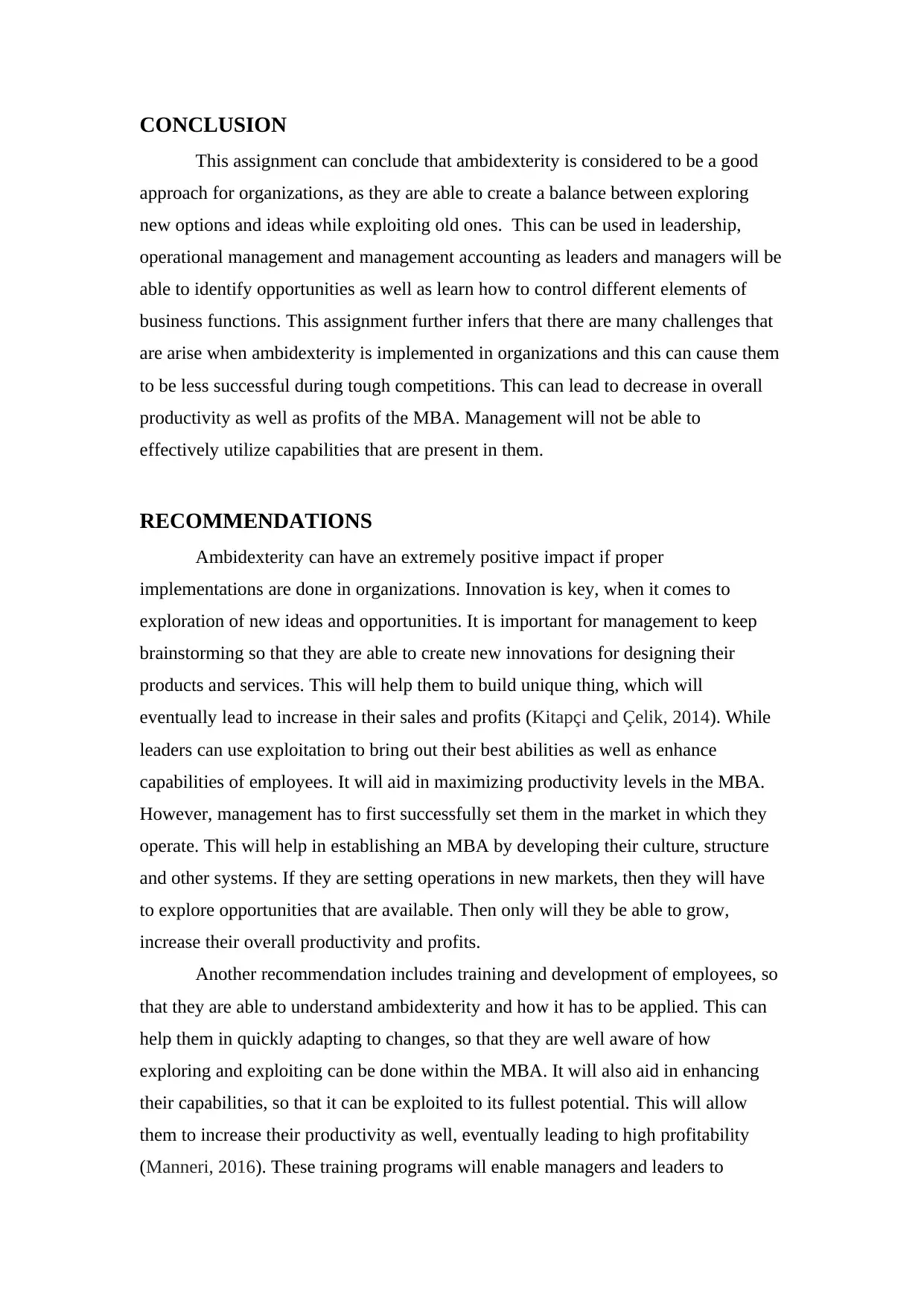
CONCLUSION
This assignment can conclude that ambidexterity is considered to be a good
approach for organizations, as they are able to create a balance between exploring
new options and ideas while exploiting old ones. This can be used in leadership,
operational management and management accounting as leaders and managers will be
able to identify opportunities as well as learn how to control different elements of
business functions. This assignment further infers that there are many challenges that
are arise when ambidexterity is implemented in organizations and this can cause them
to be less successful during tough competitions. This can lead to decrease in overall
productivity as well as profits of the MBA. Management will not be able to
effectively utilize capabilities that are present in them.
RECOMMENDATIONS
Ambidexterity can have an extremely positive impact if proper
implementations are done in organizations. Innovation is key, when it comes to
exploration of new ideas and opportunities. It is important for management to keep
brainstorming so that they are able to create new innovations for designing their
products and services. This will help them to build unique thing, which will
eventually lead to increase in their sales and profits (Kitapçi and Çelik, 2014). While
leaders can use exploitation to bring out their best abilities as well as enhance
capabilities of employees. It will aid in maximizing productivity levels in the MBA.
However, management has to first successfully set them in the market in which they
operate. This will help in establishing an MBA by developing their culture, structure
and other systems. If they are setting operations in new markets, then they will have
to explore opportunities that are available. Then only will they be able to grow,
increase their overall productivity and profits.
Another recommendation includes training and development of employees, so
that they are able to understand ambidexterity and how it has to be applied. This can
help them in quickly adapting to changes, so that they are well aware of how
exploring and exploiting can be done within the MBA. It will also aid in enhancing
their capabilities, so that it can be exploited to its fullest potential. This will allow
them to increase their productivity as well, eventually leading to high profitability
(Manneri, 2016). These training programs will enable managers and leaders to
This assignment can conclude that ambidexterity is considered to be a good
approach for organizations, as they are able to create a balance between exploring
new options and ideas while exploiting old ones. This can be used in leadership,
operational management and management accounting as leaders and managers will be
able to identify opportunities as well as learn how to control different elements of
business functions. This assignment further infers that there are many challenges that
are arise when ambidexterity is implemented in organizations and this can cause them
to be less successful during tough competitions. This can lead to decrease in overall
productivity as well as profits of the MBA. Management will not be able to
effectively utilize capabilities that are present in them.
RECOMMENDATIONS
Ambidexterity can have an extremely positive impact if proper
implementations are done in organizations. Innovation is key, when it comes to
exploration of new ideas and opportunities. It is important for management to keep
brainstorming so that they are able to create new innovations for designing their
products and services. This will help them to build unique thing, which will
eventually lead to increase in their sales and profits (Kitapçi and Çelik, 2014). While
leaders can use exploitation to bring out their best abilities as well as enhance
capabilities of employees. It will aid in maximizing productivity levels in the MBA.
However, management has to first successfully set them in the market in which they
operate. This will help in establishing an MBA by developing their culture, structure
and other systems. If they are setting operations in new markets, then they will have
to explore opportunities that are available. Then only will they be able to grow,
increase their overall productivity and profits.
Another recommendation includes training and development of employees, so
that they are able to understand ambidexterity and how it has to be applied. This can
help them in quickly adapting to changes, so that they are well aware of how
exploring and exploiting can be done within the MBA. It will also aid in enhancing
their capabilities, so that it can be exploited to its fullest potential. This will allow
them to increase their productivity as well, eventually leading to high profitability
(Manneri, 2016). These training programs will enable managers and leaders to
⊘ This is a preview!⊘
Do you want full access?
Subscribe today to unlock all pages.

Trusted by 1+ million students worldwide
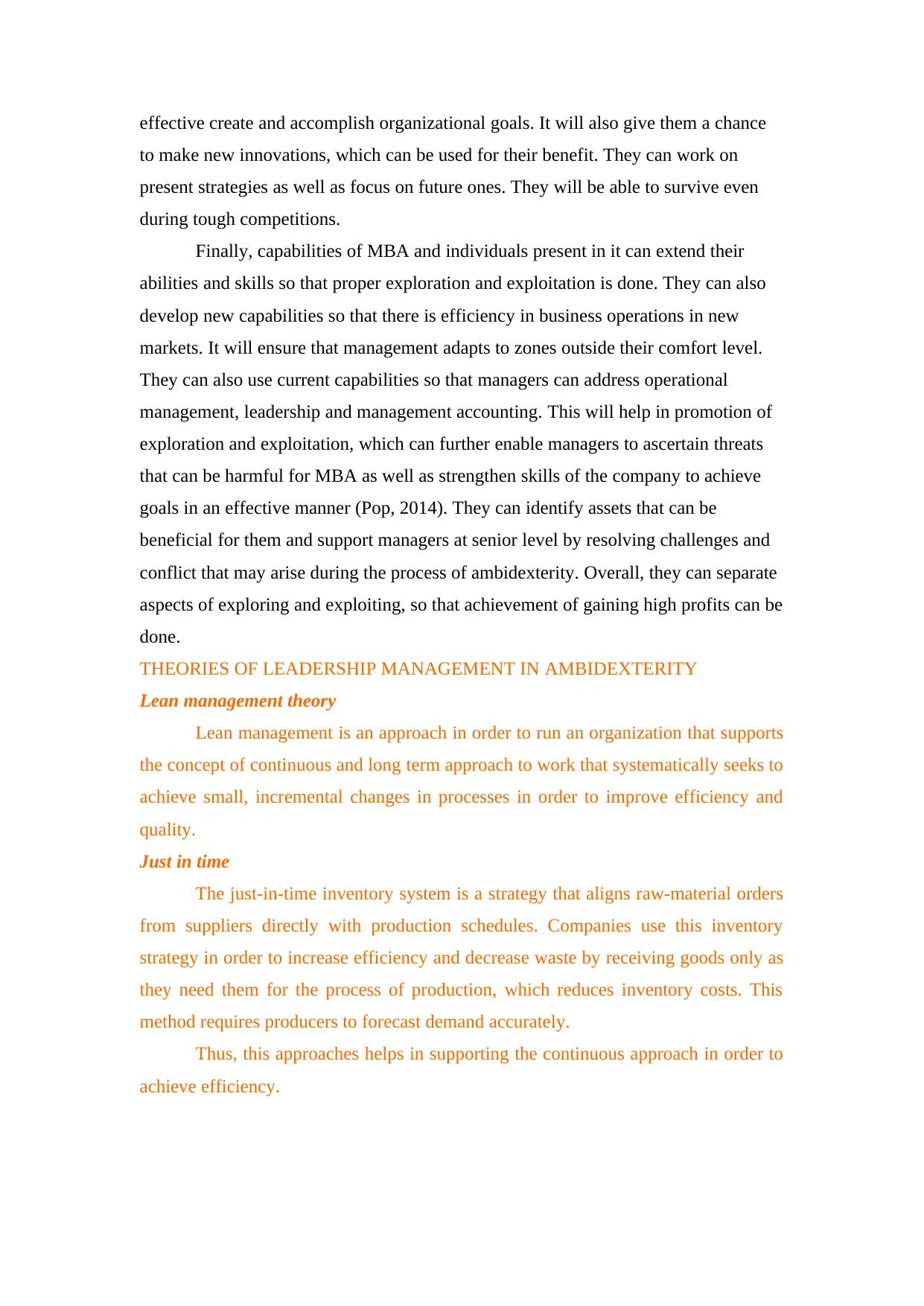
effective create and accomplish organizational goals. It will also give them a chance
to make new innovations, which can be used for their benefit. They can work on
present strategies as well as focus on future ones. They will be able to survive even
during tough competitions.
Finally, capabilities of MBA and individuals present in it can extend their
abilities and skills so that proper exploration and exploitation is done. They can also
develop new capabilities so that there is efficiency in business operations in new
markets. It will ensure that management adapts to zones outside their comfort level.
They can also use current capabilities so that managers can address operational
management, leadership and management accounting. This will help in promotion of
exploration and exploitation, which can further enable managers to ascertain threats
that can be harmful for MBA as well as strengthen skills of the company to achieve
goals in an effective manner (Pop, 2014). They can identify assets that can be
beneficial for them and support managers at senior level by resolving challenges and
conflict that may arise during the process of ambidexterity. Overall, they can separate
aspects of exploring and exploiting, so that achievement of gaining high profits can be
done.
THEORIES OF LEADERSHIP MANAGEMENT IN AMBIDEXTERITY
Lean management theory
Lean management is an approach in order to run an organization that supports
the concept of continuous and long term approach to work that systematically seeks to
achieve small, incremental changes in processes in order to improve efficiency and
quality.
Just in time
The just-in-time inventory system is a strategy that aligns raw-material orders
from suppliers directly with production schedules. Companies use this inventory
strategy in order to increase efficiency and decrease waste by receiving goods only as
they need them for the process of production, which reduces inventory costs. This
method requires producers to forecast demand accurately.
Thus, this approaches helps in supporting the continuous approach in order to
achieve efficiency.
to make new innovations, which can be used for their benefit. They can work on
present strategies as well as focus on future ones. They will be able to survive even
during tough competitions.
Finally, capabilities of MBA and individuals present in it can extend their
abilities and skills so that proper exploration and exploitation is done. They can also
develop new capabilities so that there is efficiency in business operations in new
markets. It will ensure that management adapts to zones outside their comfort level.
They can also use current capabilities so that managers can address operational
management, leadership and management accounting. This will help in promotion of
exploration and exploitation, which can further enable managers to ascertain threats
that can be harmful for MBA as well as strengthen skills of the company to achieve
goals in an effective manner (Pop, 2014). They can identify assets that can be
beneficial for them and support managers at senior level by resolving challenges and
conflict that may arise during the process of ambidexterity. Overall, they can separate
aspects of exploring and exploiting, so that achievement of gaining high profits can be
done.
THEORIES OF LEADERSHIP MANAGEMENT IN AMBIDEXTERITY
Lean management theory
Lean management is an approach in order to run an organization that supports
the concept of continuous and long term approach to work that systematically seeks to
achieve small, incremental changes in processes in order to improve efficiency and
quality.
Just in time
The just-in-time inventory system is a strategy that aligns raw-material orders
from suppliers directly with production schedules. Companies use this inventory
strategy in order to increase efficiency and decrease waste by receiving goods only as
they need them for the process of production, which reduces inventory costs. This
method requires producers to forecast demand accurately.
Thus, this approaches helps in supporting the continuous approach in order to
achieve efficiency.
Paraphrase This Document
Need a fresh take? Get an instant paraphrase of this document with our AI Paraphraser
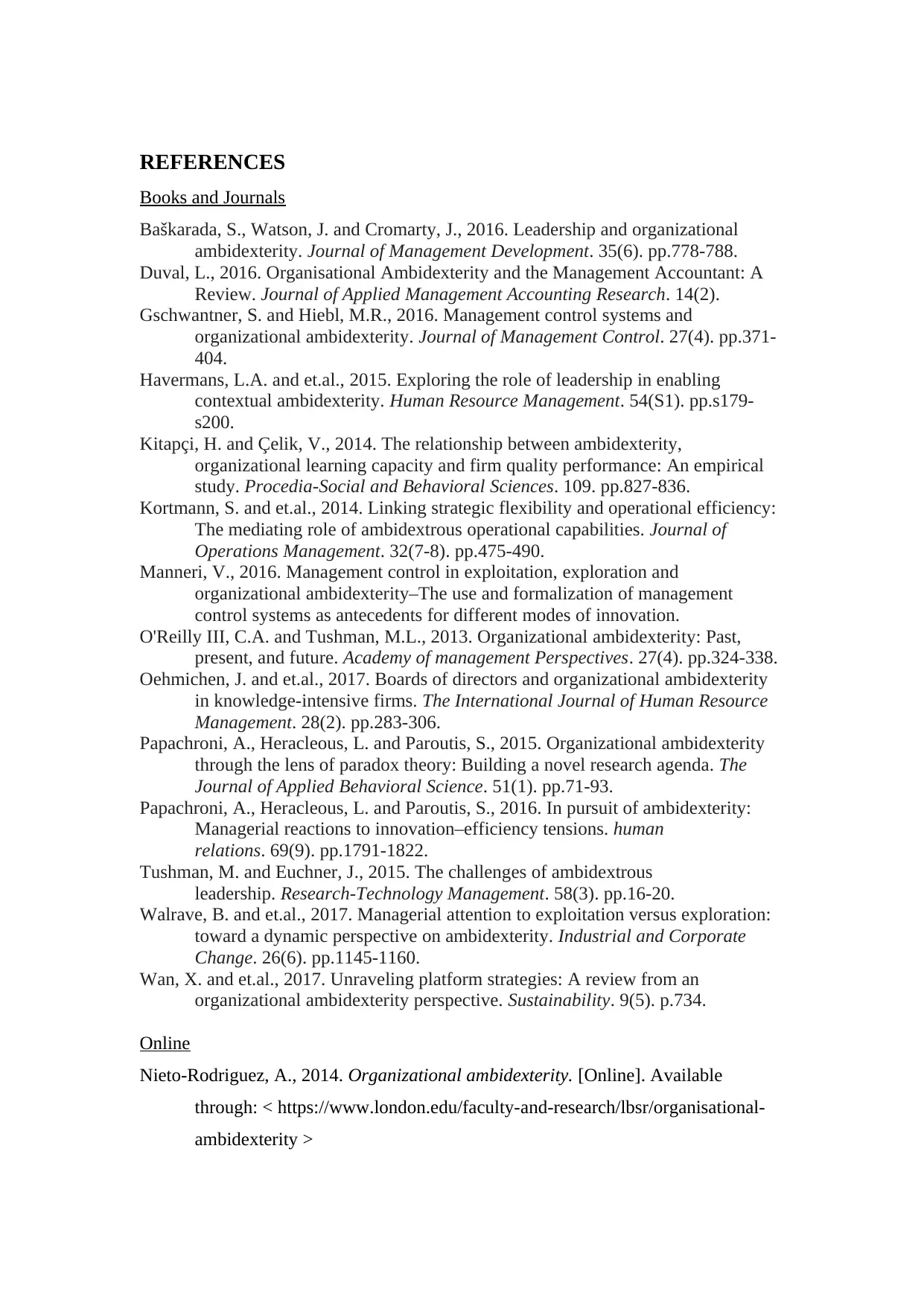
REFERENCES
Books and Journals
Baškarada, S., Watson, J. and Cromarty, J., 2016. Leadership and organizational
ambidexterity. Journal of Management Development. 35(6). pp.778-788.
Duval, L., 2016. Organisational Ambidexterity and the Management Accountant: A
Review. Journal of Applied Management Accounting Research. 14(2).
Gschwantner, S. and Hiebl, M.R., 2016. Management control systems and
organizational ambidexterity. Journal of Management Control. 27(4). pp.371-
404.
Havermans, L.A. and et.al., 2015. Exploring the role of leadership in enabling
contextual ambidexterity. Human Resource Management. 54(S1). pp.s179-
s200.
Kitapçi, H. and Çelik, V., 2014. The relationship between ambidexterity,
organizational learning capacity and firm quality performance: An empirical
study. Procedia-Social and Behavioral Sciences. 109. pp.827-836.
Kortmann, S. and et.al., 2014. Linking strategic flexibility and operational efficiency:
The mediating role of ambidextrous operational capabilities. Journal of
Operations Management. 32(7-8). pp.475-490.
Manneri, V., 2016. Management control in exploitation, exploration and
organizational ambidexterity–The use and formalization of management
control systems as antecedents for different modes of innovation.
O'Reilly III, C.A. and Tushman, M.L., 2013. Organizational ambidexterity: Past,
present, and future. Academy of management Perspectives. 27(4). pp.324-338.
Oehmichen, J. and et.al., 2017. Boards of directors and organizational ambidexterity
in knowledge-intensive firms. The International Journal of Human Resource
Management. 28(2). pp.283-306.
Papachroni, A., Heracleous, L. and Paroutis, S., 2015. Organizational ambidexterity
through the lens of paradox theory: Building a novel research agenda. The
Journal of Applied Behavioral Science. 51(1). pp.71-93.
Papachroni, A., Heracleous, L. and Paroutis, S., 2016. In pursuit of ambidexterity:
Managerial reactions to innovation–efficiency tensions. human
relations. 69(9). pp.1791-1822.
Tushman, M. and Euchner, J., 2015. The challenges of ambidextrous
leadership. Research-Technology Management. 58(3). pp.16-20.
Walrave, B. and et.al., 2017. Managerial attention to exploitation versus exploration:
toward a dynamic perspective on ambidexterity. Industrial and Corporate
Change. 26(6). pp.1145-1160.
Wan, X. and et.al., 2017. Unraveling platform strategies: A review from an
organizational ambidexterity perspective. Sustainability. 9(5). p.734.
Online
Nieto-Rodriguez, A., 2014. Organizational ambidexterity. [Online]. Available
through: < https://www.london.edu/faculty-and-research/lbsr/organisational-
ambidexterity >
Books and Journals
Baškarada, S., Watson, J. and Cromarty, J., 2016. Leadership and organizational
ambidexterity. Journal of Management Development. 35(6). pp.778-788.
Duval, L., 2016. Organisational Ambidexterity and the Management Accountant: A
Review. Journal of Applied Management Accounting Research. 14(2).
Gschwantner, S. and Hiebl, M.R., 2016. Management control systems and
organizational ambidexterity. Journal of Management Control. 27(4). pp.371-
404.
Havermans, L.A. and et.al., 2015. Exploring the role of leadership in enabling
contextual ambidexterity. Human Resource Management. 54(S1). pp.s179-
s200.
Kitapçi, H. and Çelik, V., 2014. The relationship between ambidexterity,
organizational learning capacity and firm quality performance: An empirical
study. Procedia-Social and Behavioral Sciences. 109. pp.827-836.
Kortmann, S. and et.al., 2014. Linking strategic flexibility and operational efficiency:
The mediating role of ambidextrous operational capabilities. Journal of
Operations Management. 32(7-8). pp.475-490.
Manneri, V., 2016. Management control in exploitation, exploration and
organizational ambidexterity–The use and formalization of management
control systems as antecedents for different modes of innovation.
O'Reilly III, C.A. and Tushman, M.L., 2013. Organizational ambidexterity: Past,
present, and future. Academy of management Perspectives. 27(4). pp.324-338.
Oehmichen, J. and et.al., 2017. Boards of directors and organizational ambidexterity
in knowledge-intensive firms. The International Journal of Human Resource
Management. 28(2). pp.283-306.
Papachroni, A., Heracleous, L. and Paroutis, S., 2015. Organizational ambidexterity
through the lens of paradox theory: Building a novel research agenda. The
Journal of Applied Behavioral Science. 51(1). pp.71-93.
Papachroni, A., Heracleous, L. and Paroutis, S., 2016. In pursuit of ambidexterity:
Managerial reactions to innovation–efficiency tensions. human
relations. 69(9). pp.1791-1822.
Tushman, M. and Euchner, J., 2015. The challenges of ambidextrous
leadership. Research-Technology Management. 58(3). pp.16-20.
Walrave, B. and et.al., 2017. Managerial attention to exploitation versus exploration:
toward a dynamic perspective on ambidexterity. Industrial and Corporate
Change. 26(6). pp.1145-1160.
Wan, X. and et.al., 2017. Unraveling platform strategies: A review from an
organizational ambidexterity perspective. Sustainability. 9(5). p.734.
Online
Nieto-Rodriguez, A., 2014. Organizational ambidexterity. [Online]. Available
through: < https://www.london.edu/faculty-and-research/lbsr/organisational-
ambidexterity >

Pop, O. M., 2014. Organizational ambidexterity- a glimpse at the state-of-the-art.
[Online]. Available through: <
https://blog.hypeinnovation.com/organizational-ambidexterity-a-glimpse-at-
the-state-of-the-art>
[Online]. Available through: <
https://blog.hypeinnovation.com/organizational-ambidexterity-a-glimpse-at-
the-state-of-the-art>
⊘ This is a preview!⊘
Do you want full access?
Subscribe today to unlock all pages.

Trusted by 1+ million students worldwide
1 out of 12
Related Documents
Your All-in-One AI-Powered Toolkit for Academic Success.
+13062052269
info@desklib.com
Available 24*7 on WhatsApp / Email
![[object Object]](/_next/static/media/star-bottom.7253800d.svg)
Unlock your academic potential
Copyright © 2020–2025 A2Z Services. All Rights Reserved. Developed and managed by ZUCOL.





